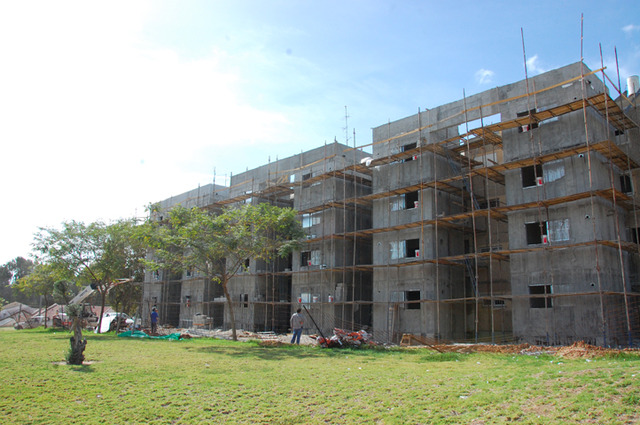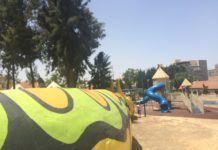Upon arriving in the small southern Israeli town of Sderot it is easy to remark upon just how unremarkable it is. The buildings are modern and simple, the shops functional, and the people kind and friendly speaking little English. Just regular people going about their daily lives. However, open your eyes a little wider and an alternative story becomes apparent; Bus stops are made of reinforced concrete, odd looking thickly square attachments to people’s houses are common, and the innocent looking balloon that floats in the sky and is actually equipped with heat detection sensors. Lying in close proximity to the Gaza border this town has been described as the ‘beleaguered war zone’ that bears the brunt of the much publicised Qassam rocket attacks by Gazan militants.
As part of my visit to the Sderot Media centre I was taken on a tour of the city. Just near the office is a children’s play ground. In addition to the regular tools of child play; swings, slides and climbing frames, the playground shows off a giant, thick and brightly coloured caterpillar, whose friendly visage conceals its life saving use as bomb shelter. This new initiative is an attempt at allowing children here to have as close to normal lives as is possible. Without such measures it might be deemed too dangerous for children to play in open spaces. Every excursion is planned meticulously to ensure that a bomb shelter is always at close proximity. This is a cat and mouse game, a place where deciding whether or not to go and buy apples from the shop becomes a life or death decision should a Qassam rocket choose to hit. ‘Fun’ coloured bomb shelters or not, the psychological impact of constantly falling rockets is severe. According to a recently published survey one in three children here suffer from post traumatic stress disorder.
Hearing the resident’s stories, it is easy to understand how such survey results are tragically accurate. In 2007, the year that Hamas came to power, 2,313 rockets and mortar shells were fired from Gaza and in January 2008 the figures grew to reach an average of 12 rockets and mortars per day. Children as young as two know how to react when they hear the siren. Emitted by the heat detection balloon, a chillingly calm woman’s voice repeating ‘Tzeva Adom’ or ‘Code Red’ and interspersed by ominous buzzer noise blasts across the city, giving residents a 15 second warning of an incoming Qassam. With only 15 seconds to take cover every practical aspect of life is designed to allow for a quick escape. ‘Life Shield’ bomb shelters are dotted about Sderot and this is the only place in Israel where the wearing of seatbelts in cars is not compulsory. For those that have no place to take cover however, there is little to do but to wait and hope that they will not be the target of this indiscriminately aimed weapon.
Fired by Gazan militants, the rockets are crudely made out of basic day to day materials. As one policeman explained, many of the rocket tails are fashioned from the metal of road signs, the fuel of the rocket a combination of sugar and fertilizer and the shrapnel a mongrel collection of anything that can inflict pain, from nails to stones. There is a difference between hearing the facts and figures of how many rockets have hit Sderot and seeing the reality. In visiting the police station I was taken into the back yard where the hundreds of black mangled remains of the rockets, all dated and labelled, are stored. Stacked up on shelves spanning up and across two walls, the effect is sobering, especially when told that this is only a sample of what has been collected, another three thousand rockets had been cleared out the day before. My guide asks what my birth date is, and immediately points to a rocket that fell the date of my 21st birthday.
The ceasefire agreed on 21st June 2008 might have been seen as a chance to live what resembles a normal life, however, though reduced in numbers, the rockets continue to fall. Fifty have fallen since the ceasefire began, damaging or destroying numerous parts of the town. In addition to the rockets, another increasingly dangerous threat exists; the damage from mortar shells. I was taken to the Nahal Oz Kibbutz, lush green and replete with a swimming pool this kibbutz seems an oasis of calm, but Gaza city is clearly visible through the triple layered electric fencing barrier that separates the two sides. Through the barred gates and concrete walls I could see tanks roaming, nervous Israeli soldiers with guns, a hint of the high tensions here. Walking through the Kibbutz I was told how almost every house here has been hit by a mortar shell of some kind, the kindergarten there had an oddly shaped reinforced roof. Unlike the rockets these mortar shells are not detected by Tzeva Adom and as such hit without warning.
I gained an insight into the fear of such a livelihood as I spent the night in Sderot. Taken in by Izik, the deputy manager of SMC I was in his house just outside of Sderot. Faintly covered by the whirr of the air conditioning fan were ominious blast and boom sounds. Unlike anything that I had heard before, my ears pricked and heart gave a nervous thud. Izik, accustomed to rockets and mortars, didn’t give the slightest acknowledgement of the noises and continued to speak nonchalantly. The noises carried on and I found it increasingly difficult to focus on what we were talking about, not wanting to seem cowardly I tried to hide the fact that part of me was yearning to take my bedding and go to the nearby bomb shelter. Seeing my nerves Izik tried to calm me; ‘don’t worry, the closest anything has ever hit to here is 200 meters’! Gradually the booms got louder, and a helicopter whirred above, an indication that something was happening. Whatever the noises where, whether mortar shells, or fighting within Gaza, they kept me awake my ears refusing to tune them out as I tried to sleep. At one point I even felt the house shake a little. Although for the people pf Sderot this is a negligible incident, if considered an incident at all, for me it was an experience I will not forget easily.
The situation in Sderot is unique in Israel. The residents here are not choosing to put themselves under such fire for political or religious reasons. They are not comparable the zealous settlers in Hebron, whose legitimacy of residency is politically contentious and their motivation religious. Were this the case the Qassam rocket attacks might have to be viewed in a different context. The 23,000 residents of Sderot are predominantly non-political working class people whose town has the misfortune of being caught in the cross fire of the ongoing conflict between Israel and Gaza. Many have fled the city and many of those who remain do so because to leave is not economically viable, some have stated that were the government to provider the funding they would gladly evacuate. In fact, much of the resident’s anger is not directed at Gazan militia men but at their own government. They highlight that were the city under fire Tel Aviv, or a richer area this violence would not be allowed to continue. They argue that, unsure of how to deal with the problem, the government of chooses to ignore it. In fact Sderot is one of the only towns in Israel whose councillor does not have directly clear links or supervision from the national government. If they did, one resident told me, they would have to accept responsibility for what is happening here. With every Israeli incursion into Gaza, the number of Qassam rockets reigning upon Sderot increase. It seems that military violence is not the answer, it simply results in a downward spiral for the livelihoods of residents on either side of the fence. For the people of Sderot it seems that, as politicians continue to lip service peace over coffee, there is little to do but endeavour to lead a normal life whilst teaching their children to play in dressed up bomb shelters.












Thank you for this well written, factual and to the point article. Just what I need to send/show people. My husband and I visit Sderot near the beginning of each school year to bring backpacks for children starting school.Our main contact at Sderot Media has been Anav Silverman. Is she still there? If not can we please be in contact with her replacement. We have already started to raise funds and prepare backpacks for July 2009. Yes it is a long process. We very often think of Sderot and send our warm greetings and prayers. Regards please to Noam Bedien. Shalom Mati.Tel 04-639-8485 (not to be passed on without permission).